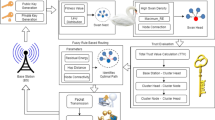Abstract
The approach of innovation has led the expanded enthusiasm for oneself arranging Ad-hoc Networks. Amongst the various constraints that relates to mobile infrastructure-less networking condition with reduced storage utility as the power storage facilities, influence utilization and vitality advancement stays a very significant issue. In our proposed the self formation nodes in the cloud scenario has been channelized properly through the cluster head (CH) and transmission head (TH) selection. Moreover the proposed technique Friendly Ad-hoc Routing in Cloud Scenario (FARICS) is introduced to enrich the security features of Mobile Ad hoc Network (MANET) architecture. The malicious nodes were found out sincerely through various traffic tables to enrich the security of the MANET. The first preliminary approach of the nodes combination will be vary from cluster to cluster. The CH, TH combination from one cluster to another cluster will be varied according to the sense of the node. The cluster may be a cloud form of organisation to represent the mobile ad hoc nodes. The unique identity of each node were monitored and mapped through the traffic table and the connectivity of the nodes will be strengthening. The simulation will be done with SAODV, SZRP and DMR protocols to get a successful result.









Similar content being viewed by others
References
Agrawal DP, Zeng QA (2002) Introduction to wireless and mobile systems. Brooks/Cole, Thomson, Pacific Grove, CA
Ajay K, Amit KK (2016) Performance analysis of AODV, DSR & LAR1 routing protocols for MANET. In: ACEIT-16 Conference in Integral University
Arunkumar BR, Kavya LH (2016) Topological analysis of K-connected MANETs using connectivity index, randic and euclidian energy. In: IEEE international conference on recent trends in electronics information communication technology, India, 978-1-5090-0774-5/16, pp: 2077–2082
Awad OA, Mariam R (2016) An efficient energy aware ZRP – fuzzy clustering protocol for WSN. Int J Sci Eng Res 7(3):1060–1065
Chen B, Jamieson K, Balakrishnan H, Morris R (2002) SPAN: Span: an energy-efficient coordination algorithm for topology maintenance in ad hoc wireless networks. Wireless Netw 8(5):481–494
Chlamtac I, Conti M, Liu JN (2003) Mobile ad hoc networking: imperatives and challenges. In: Ad-Hoc networks, New York, vol 1, Elsevier, pp 13–64
Deepa M, Indu K, Sherin Z (2017) Random cluster head selection based routing approach for energy enrichment in MANET. In: Proceeding international conference on recent innovations is signal processing and embedded systems, 978-1-5090-4760-4/17, pp 119–123
Ghode S, Bhoyar KK (2016) NEMA: Node energy monitoring algorithm for zone head selection in mobile ad-hoc network using residual battery power of node. In: International conference on wireless communications, signal processing and networking (WiSPNET), pp 1999–2004
Jayakumar G, Gopinath G (2007) Ad-hoc mobile wireless networks routing protocol: a review. J Comput Sci 3(8):574–582
Johnson D, Maltz D (1996) Dynamic source routing in ad hoc wireless networks. Mob Comput Chap 5:153–181
Kim KJ, Koo HW (2017) Optimizing power-aware routing using zone routing protocol in MANET. In: IFIP international conference on network and parallel computing workshops, Liaoning, pp 670–675
Nasser N, Chen Y (2007) Enhanced intrusion detection system for discovering malicious nodes in mobile ad hoc network. In: Proceedings of IEEE international conference on communication, Scotland, pp. 1154–1159
Pallavi SK, Vijay RG (2016) Comparative study of network simulator: NS2 and NS3. Int J Adv Res Comput Sci Softw Eng 6:608–612
Patcha A, Mishra A (2003) Collaborative security architecture for black hole attack prevention in mobile ad-hoc networks. In: Proceedings of radio wireless conference, pp 75–78
Rajendra P, Shivashankar P (2017) Multitier energy system review on secure intrusion detection system in MANETs. In: IEEE international conference on recent trends in electronics information and communication technology, India, 978-1-5090-3704-9/17, pp 1722–1726
Ravi G, Kashwan KR (2013) A new routing protocol for energy efficient mobile applications for ad hoc networks. In: International Review on Computers and Software (I.RE.CO.S.), Vol 8, Number 10
Satyam KS, Ravi RC, Ajay K (2016) Performance evaluation of routing protocols based on different models in MANET. In: IEEE international conference on recent trends in electronics information communication technology, India, 978-1-5090-0774-5/16, pp 1666–1670
Wang L, Zhang NT (2002) Locally forwarding location management in ad-hoc networks. In: Proceedings of IEEE international conference on communications, circuits and systems and west sino expositions, pp 160–164
Author information
Authors and Affiliations
Corresponding author
Additional information
Publisher's Note
Springer Nature remains neutral with regard to jurisdictional claims in published maps and institutional affiliations.
Rights and permissions
About this article
Cite this article
Parthasarathy, R., Shanmugapriyan, J. Friendly ad hoc routing in cloud scenario using CH selection and transmission head to enrich the security mechanism. J Ambient Intell Human Comput 12, 3189–3198 (2021). https://doi.org/10.1007/s12652-020-02477-y
Received:
Accepted:
Published:
Issue Date:
DOI: https://doi.org/10.1007/s12652-020-02477-y




